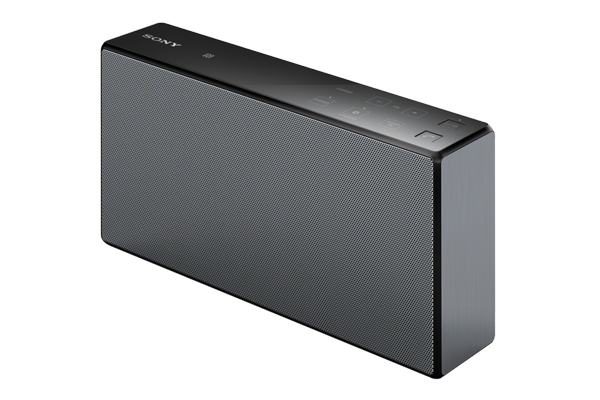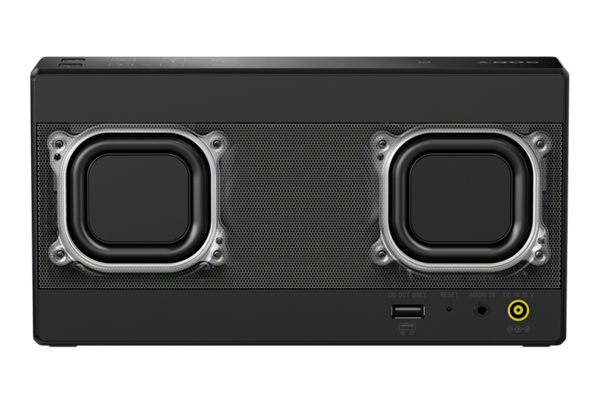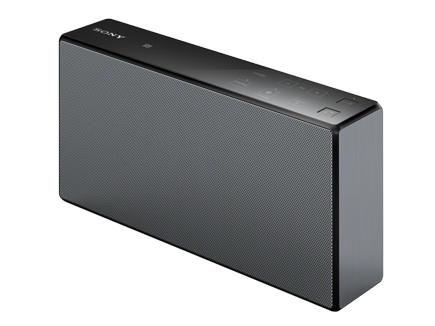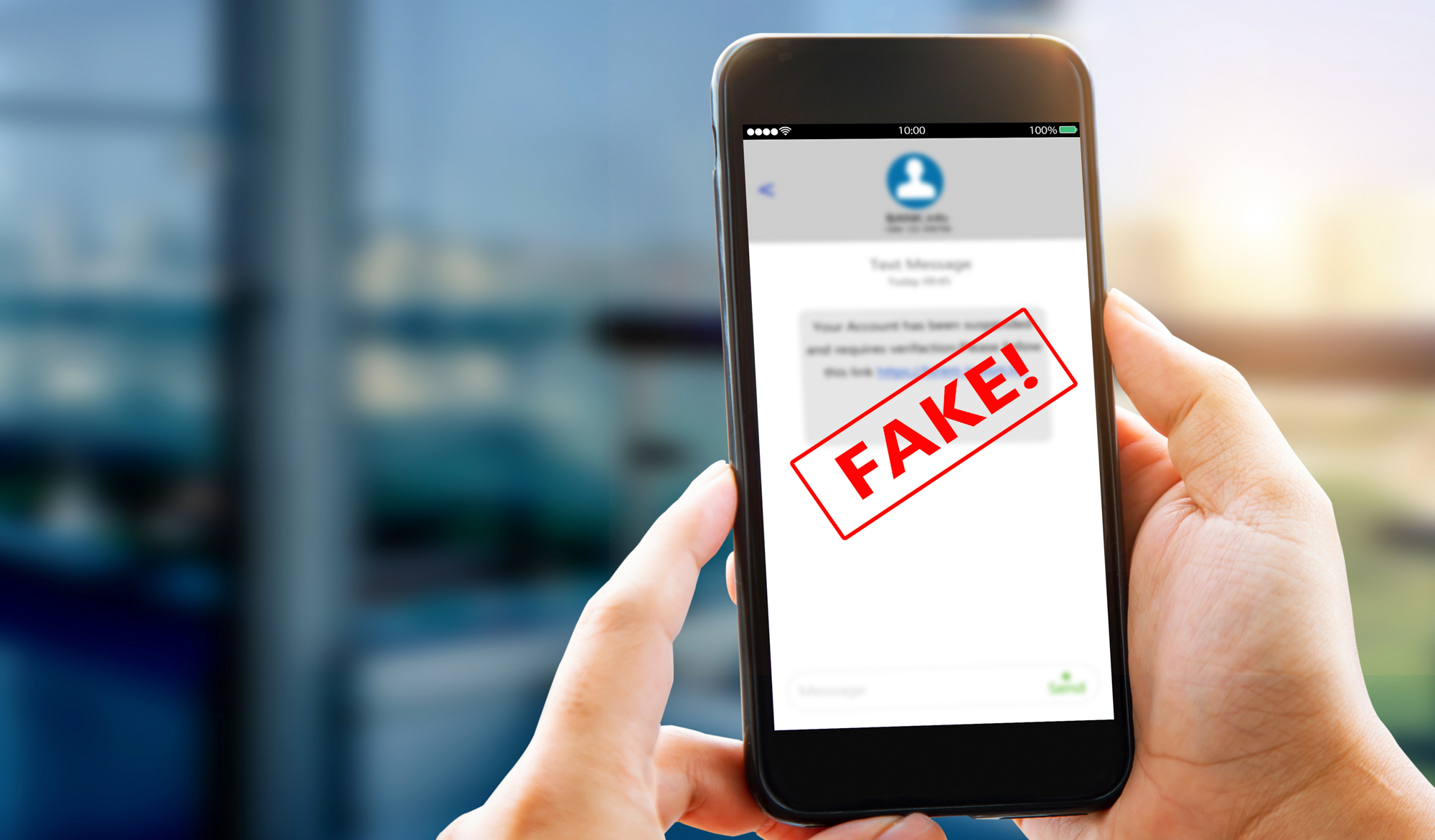Tom's Guide Verdict
Sony's latest Bluetooth speaker impresses with excellent sound quality for the price, but its large size and weak battery life limit its portability.
Pros
- +
Booming bass
- +
Crisp treble
- +
Enough volume to fill a large room.
Cons
- -
Limited battery life
- -
Heavy
- -
Poor microphone for speakerphone.
Why you can trust Tom's Guide

Sony used to be synonymous with portable audio — remember the Walkman? And although its dominance in the area has waned, it has remained a go-to brand for home audio. However, newer names like Ultimate Ears and Braven have taken the spotlight in the portable Bluetooth speaker arena. Sony's latest Bluetooth speaker, the $180 SRS-X55, boasts two drivers and a subwoofer inside. Can it help Sony regain clout in portable audio?
Design
The 8.8 x 4.8 x 2-inch SRS-X55 aims for elegance and simplicity, instead of the bright colors and rounded edges of similarly priced Bluetooth speakers such as the $200 UE Boom or the $200 Bose SoundLink Mini. It is available only in black.

It's portable in a strict sense of the word; its built-in battery lets you move it around, but at 2.6 pounds — more than twice the weight of the 1.18-pound UE Boom — you won't want to take it far. It also lacks the ruggedness of the UE Boom and the $180 Fugoo Style, both of which can withstand getting wet.
Inside the case, Sony packed two 1.5-inch drivers and a large, 2.4-inch subwoofer, which accounts for some of the mass and also helps it deliver booming bass and crisp treble.

The SRS-X55 includes buttons for power, volume, Bluetooth pairing and answering calls on the top right, along with a button to engage Clearaudio, its vocal-boosting technology. Next to the volume buttons, a Charge indicator blinks orange when the battery power gets low. The unit doesn't include any buttons for controlling music playback; you use your music source for that.
On the back, Sony placed a USB port for charging mobile devices, a 3.5-mm auxiliary input for wired connections, and a 15-volt DC power input for charging the speaker.

Setup
Get instant access to breaking news, the hottest reviews, great deals and helpful tips.
The SRS-X55 paired easily with iOS and Android devices. It includes NFC for quick pairing with Android devices that support the technology. For manual Bluetooth pairing, you simply press the Bluetooth button on top of the unit and find "SRS-X55" under available devices in your device's Bluetooth settings menu.
Sony doesn't state the wireless range for the speaker, but I found it maintained a strong connection to my iPhone at 25 feet, even with walls between the speaker and the phone.
MORE: Best Bluetooth Speakers
There's no app to make adjustments to the sound, like you'll find with the UE Boom. If you press the Sound button on the top of the unit, it engages Clearaudio.
Performance
All types of music sound great on the SRS-X55, which is impressive for a speaker that costs less than $200.
On Mark Ronson's "Uptown Funk," the bass thumped with tactile impact — I could feel it vibrate in my chest more than I could on most Bluetooth speakers. The Bose SoundLink Mini produces comparable bass levels, but the Sony eclipsed the Bose when it came to midranges and treble tones. The horns on the "Uptown Funk" sounded brighter and sharper on the SRS-X55, and the vocals resounded clearly, for an all-around balanced sound.
The same was true for other songs I listened to. Florence Welch's impassioned singing on Florence + the Machine's "What Kind of Man" soared above the guitars and horns in the background, and the bass provided a strong drive to the song. Jimmy Page's distorted guitars and John Paul Jones' bass blended nicely with Robert Plant's vocals on Led Zeppelin's "Houses of the Holy."

The speaker performed well on acoustic music, too. Miles Davis' muted trumpet on "Summertime" was crisp and bright, and the acoustic bass was clear, providing a better overall balance than the SoundLink Mini.

Sony uses a proprietary compression technology called LDAC, which it says doesn't compress high-resolution music as much as traditional Bluetooth does. When listening to a 96-kHz/24-bit version of Miles Davis' "So What," I found the horns brighter and the cymbals crisper than on the 320-Kbps MP3 version.
With each driver rated at 5 watts, the speaker puts out enough power to fill a large room. I measured the max volume at 90 decibels, but it sounded much less distorted at 85 decibels.
Speakerphone
Like most current Bluetooth speakers, the SRS-X55 includes a microphone for conferencing. Thanks to its bass and big sound, it made the voices of the people I spoke with much easier to hear compared with the built-in speakerphone on the iPhone.
MORE: Best Headphones
However, the people on the other end of the line had trouble hearing me. The people I spoke with said the microphone on the SRS-X55 distorted my voice and made me more difficult to understand than when I used the iPhone.
Battery Life
Sony says a full charge of the SRS-X55 will get you 10 hours of music play. I found that to be accurate, as it ran out of power after about 10 hours of playing at moderate volume. While that's better than the Bose SoundLink Mini's 7 hours, many other Bluetooth speakers near this price offer far better endurance, such as the UE Boom's 15 hours and the Fugoo Style's whopping 40 hours.
The SRS-X55 uses an AC adapter to recharge the battery, which makes it less useful for travel, since you have to pack its charger instead of the micro-USB cable that most portable Bluetooth speakers use.
Bottom Line
If you're looking for excellent sound in a Bluetooth speaker that costs less than $200, Sony's latest option will meet your needs. Its simple style helps it blend into the background of your home or office, and it has plenty of power to fill large spaces. But with limited battery life and no ruggedness, the SRS-X55 isn't a good candidate if you plan to listen away from your home often.
- Best Fitness Trackers for Running, Swimming and Training
- Our Favorite Soundbars for Small and Big TVs
- Best 2-in-1s (Laptop/Tablet Hybrids)
Follow Michael Gowan @zebgowan and on Google+. Follow us @tomsguide, on Facebook and on Google+.

Michael Gowan is a freelance technology journalist covering soundbars, TVs, and wireless speakers of all kinds of shapes and sizes for Tom’s Guide. He has written hundreds of product reviews, focusing on sound quality and value to help shoppers make informed buying decisions. Micheal has written about music and consumer technology for more than 25 years. His work has appeared in publications including CNN, Wired, Men’s Journal, PC World and Macworld. When Michael’s not reviewing speakers, he’s probably listening to one anyway.
-
I bought this speaker in Japan, just wondering it only took approx 2.5 hours to fully charge the battery while the manual says it would take 4 hours.Reply

